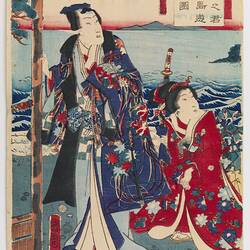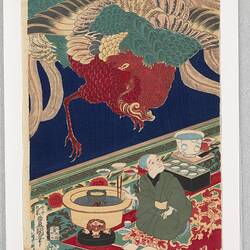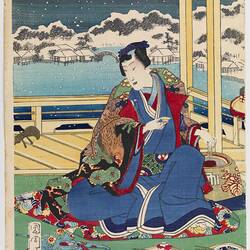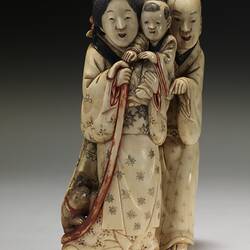Summary
Woodblock print on paper, depicting two richly dressed Japanese female attendants on the shore of Enoshima Island, produced by the Japanese woodblock artist Toyohara Kunichika (1835-1900), carved by Mi no and published by Kiya Sojiro in Tokyo, Japan, in October 1863. It is the left panel of an original triptych; a work of art comprised of three distinct panels, titled 'Genji excursion to Enoshima Island' (Genji no kimi Enoshima Yuran no Zu).
Although works by this artist are not listed in the official catalogue, it was possibly exhibited by a retailer at the Japanese court at the 1880 Melbourne International Exhibition where it was bought by John Twycross.
Woodblock prints like one could have been exhibited under two categories: Class 22, Printed Paperhangings, or Class 42, Toys.
In Printed Paperhangings, G. Inouye from Osaka exhibited 'Printed Paperhangings', Kiriu-Kosho Kuwaisha (now spelt Kiriu-Kosho Kaisha) and T. Akiyama of Tokyo exhibited 'Paperhangings and artistic papers' and M. Tani, Osaka, exhibited 'Printed Paperhangings'. Printed paperhangings, as a nineteenth century term, often referred to wall papers.
In Class 42, Toys, Kiriu-Kosho Kuwaisha and T. Akiyama of Tokyo are listed as having exhibited 'Dolls, Playing Balls, Painted Pictures, &c'. It is more likely that artistic wood block prints such as this one would have been exhibited in this category because of the vivid, graphic subject matter, that so clearly tells a story.
The scene is a Genji-e or Mitate-e; a parody illustration of the original Genji story. A popular subject for many Japanese print - or Ukiyo-e - artists in the nineteenth century, 'The Tale oF Genji', the classical Japanese novel by Lady Murasaki Shikibu of the late Heian period (794-1185 AD), detailed the lengthy, often complex love adventures of the novel's central character, Prince Genji. The story spawned many parodies, illustrations of which were also prevalent and often termed mitate-e.
In this image, two female attendants are seen seated on what appears to be a short pier at the edge of the bay with lanterns hanging in a tree above them. In the full composition, including the central and right panels of the triptych, Genji travels to Enoshima Island (Kanagawa prefecture) with attendants, with the Izu peninsula (Shizuoka Prefecture) visible in the background of the right panel.
To many in the Melbourne Exhibition's largely western audience, the flattened pictorial form and composition of Japanese prints remained puzzling, and often misunderstood. 'The Japanese pictures were very curious, some of the figures being made to rise considerably above the background', the official catalogue to the exhibition observed, while the Argus newspaper - quoted in the official catalogue - commented of the display of porcelain figures that although 'Stamped with character...the human figure more often than otherwise [is] grotesque in position and humorous in expression.'
Physical Description
Signed Japanese coloured wood block print on paper depicting two richly dressed women on the shore of Enoshima Island, having just arrived with Prince Genji (not depicted in this panel, but in the middle panel of the triptych).
More Information
-
Collection Names
-
Collecting Areas
-
Acquisition Information
Cultural Gifts Donation from Dr Will Twycross, 23 Jan 2009
-
Acknowledgement
Donated through the Australian Government's Cultural Gifts Program
-
Place & Date Made
Japan, Oct 1863
late Edo Period; Edo Period, 1603-1867; Meiji Period, 1868-1912 -
Artist
Toyohara Kunichika, Tokyo, Kanto, Honshu, Japan, Oct 1863
early Meiji Period; Edo Period, 1603-1867; Meiji Period, 1868-1912 -
Publisher
Sojiro Kiya, Tokyo, Kanto, Honshu, Japan, 1863
early Meiji Period; Edo Period, 1603-1867; Meiji Period, 1868-1912 -
Place & Date Exhibited
Royal Exhibition Building (REB), Nicholson Street, Carlton, Greater Melbourne, Victoria, Australia, 1880
-
Collector
Mr John Twycross, Elsternwick, Greater Melbourne, Victoria, Australia, 1880-1881
-
Inscriptions
Signature (Japanese marking): Kunichika Ga Signature (English marking): drawn by Kunichika Censor Seal: Aratame (inspected) with I 10 Censor Seal (English marking): Year of Wild Boar [ie. 1863] , October Carver (Hori-shi): Mi no Date of manufacture: October, 1863 (End of Edo) Publisher (Hanmoto/Shri-shi): Kiya Sojiro Place of manufacture: Edo (Tokyo), Japan
-
Medium
Ink
-
Technique
Print
-
Support
Paper
-
Primary Inscriptions
Signature (Japanese marking): Kunichika Ga Signature (English marking): drawn by Kunichika Censor Seal: Aratame (inspected) with I 10 Censor Seal (English marking): Year of Wild Boar , October Carver (Hori-shi): Mi no Date of manufacture: October, 1863 (End of Edo) Publisher (Hanmoto/Shri-shi): Kiya Sojiro Place of manufacture: Edo (Tokyo), Japan
-
Classification
Royal exhibition building, International exhibitions, Exhibition heritage
-
Category
-
Discipline
-
Type of item
-
Dimensions
370 mm (Length), 255 mm (Width)
-
Maximum dimensions
371 mm (Length), 253 mm (Width)
Measurement From Conservation.
-
References
MIE 1880 Catalogue, Japanese Exhibits, p.572 MIE 1880 Catalogue, Introduction to the General Exhibits, Japanese Court, p.cxxi, cxxii
-
Keywords
Exhibitions: Melbourne International, 1880-1881, Folklore, Japanese Art, Prints, Royal Exhibition Building







